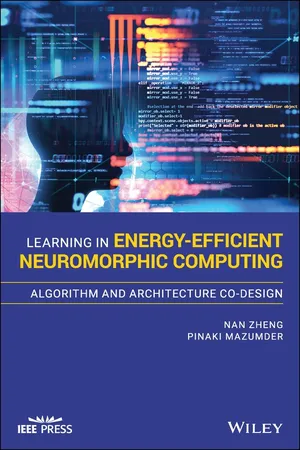
Learning in Energy-Efficient Neuromorphic Computing: Algorithm and Architecture Co-Design
- English
- ePUB (mobile friendly)
- Available on iOS & Android
Learning in Energy-Efficient Neuromorphic Computing: Algorithm and Architecture Co-Design
About this book
Explains current co-design and co-optimization methodologies for building hardware neural networks and algorithms for machine learning applications
This book focuses on how to build energy-efficient hardware for neural networks with learning capabilities—and provides co-design and co-optimization methodologies for building hardware neural networks that can learn. Presenting a complete picture from high-level algorithm to low-level implementation details, Learning in Energy-Efficient Neuromorphic Computing: Algorithm and Architecture Co-Design also covers many fundamentals and essentials in neural networks (e.g., deep learning), as well as hardware implementation of neural networks.
The book begins with an overview of neural networks. It then discusses algorithms for utilizing and training rate-based artificial neural networks. Next comes an introduction to various options for executing neural networks, ranging from general-purpose processors to specialized hardware, from digital accelerator to analog accelerator. A design example on building energy-efficient accelerator for adaptive dynamic programming with neural networks is also presented. An examination of fundamental concepts and popular learning algorithms for spiking neural networks follows that, along with a look at the hardware for spiking neural networks. Then comes a chapter offering readers three design examples (two of which are based on conventional CMOS, and one on emerging nanotechnology) to implement the learning algorithm found in the previous chapter. The book concludes with an outlook on the future of neural network hardware.
- Includes cross-layer survey of hardware accelerators for neuromorphic algorithms
- Covers the co-design of architecture and algorithms with emerging devices for much-improved computing efficiency
- Focuses on the co-design of algorithms and hardware, which is especially critical for using emerging devices, such as traditional memristors or diffusive memristors, for neuromorphic computing
Learning in Energy-Efficient Neuromorphic Computing: Algorithm and Architecture Co-Design is an ideal resource for researchers, scientists, software engineers, and hardware engineers dealing with the ever-increasing requirement on power consumption and response time. It is also excellent for teaching and training undergraduate and graduate students about the latest generation neural networks with powerful learning capabilities.
Frequently asked questions
- Essential is ideal for learners and professionals who enjoy exploring a wide range of subjects. Access the Essential Library with 800,000+ trusted titles and best-sellers across business, personal growth, and the humanities. Includes unlimited reading time and Standard Read Aloud voice.
- Complete: Perfect for advanced learners and researchers needing full, unrestricted access. Unlock 1.4M+ books across hundreds of subjects, including academic and specialized titles. The Complete Plan also includes advanced features like Premium Read Aloud and Research Assistant.
Please note we cannot support devices running on iOS 13 and Android 7 or earlier. Learn more about using the app.
Information
1
Overview
1.1 History of Neural Networks

1.2 Neural Networks in Software
1.2.1 Artificial Neural Network
1.2.2 Spiking Neural Network
1.3 Need for Neuromorphic Hardware
Table of contents
- Cover
- Table of Contents
- Preface
- Acknowledgment
- 1 Overview
- 2 Fundamentals and Learning of Artificial Neural Networks
- 3 Artificial Neural Networks in Hardware
- 4 Operational Principles and Learning in Spiking Neural Networks
- 5 Hardware Implementations of Spiking Neural Networks
- 6 Conclusions
- Appendix A
- Index
- End User License Agreement